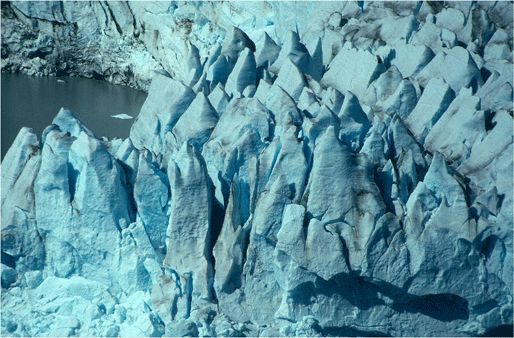Sérac
A jagged pinnacle or tower of glacier ice located on the surface of a
glacier, formed as a glacier flows down an icefall or by the intersection
of crevasses. Frequently, large areas of a glacier will be covered by séracs.

The terminus of McBride Glacier, Glacier Bay National Park, Alaska, showing
numerous pyramidal topped séracs. The individual spires
are more than 100 ft. high. |
|
|
Snowbridge
A mass of snow that has accumulated in the top of an open crevasse, masking
the existence of the crevasse. Frequently, a large void exists
below the snowbridge.

Several foot-thick accumulation
of snow covers the top of an open creavasse on
the surface of the Malaspina Glacier, Wrangell-St.Elias National Park, Alaska. |
|
|
|
|
Striations
Multiple, generally parallel, linear grooves, carved by rocks frozen in the bed of a glacier into the bedrock over which it flows.

Recently-emerged striations, located in bedrock
adjacent to the terminus of Guyot Glacier in Icy
Bay, Wrangell-St.Elias, Alaska. Note the penny for scale. |
|
|
Suncups
A series of bowl-like depression melted into a snow or ice surface, separated by a network of connected ridges. Individual suncups may be more than three feet deep and ten feet in diameter. Suncups form during warm, sunny conditions.

Differential melting has produced a field of up
to two foot-high sun cups on the surface of the
Malaspina Glacier, Wrangell-St.Elias, Alaska. |
|
|
Surge
A short-lived, frequently large-scale, increase in the rate of movement of the ice within a glacier. Ice velocities may increase 10 to 100 times above normal flow rates. In some surges, the terminus of a glacier rapidly advances. Although not all glaciers surge, those that do often surge with some sort of a periodicity.

The fractured and rapidly-calving terminus of
the surging Bering Glacier, Oct. 1993, Chugach
Mountains, in Alaska. |
|
|
|

